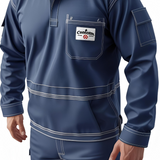Uniforms in the workplace
Uniforms in the workplace serve various purposes, from promoting professionalism to enhancing safety and team cohesion. Here’s a comprehensive overview of the benefits, types, and considerations for implementing workplace uniforms:
Benefits of Workplace Uniforms
1.Professional Appearance: Uniforms help create a polished and cohesive look, enhancing the company’s image.
2. Brand Identity**: Custom uniforms with company logos reinforce brand recognition and promote corporate identity.
3.Team Cohesion: Uniforms foster a sense of belonging among employees, promoting teamwork and unity.
4. Safety and Compliance: In industries like construction, healthcare, and food service, uniforms often include safety features that comply with regulations.
5. Customer Recognition: Uniformed employees are easily identifiable, improving customer service and communication.
6. Equality: Uniforms can minimize socioeconomic differences, creating a more inclusive work environment. ### Types of Workplace Uniforms
1. Casual Uniforms: - **Polo Shirts and Khakis**: Common in retail or casual office environments. - **Branded T-Shirts**: Suitable for informal settings and promotional events.
2Formal Uniforms
Suits and Ties: Often required in corporate or client-facing roles. - **Blazers with Dress Pants**: A professional look for meetings and formal events.
3. Industry-Specific Uniforms
Healthcare Scrubs: Worn by medical professionals for hygiene and comfort. - **Chef’s Whites**: Traditional attire for kitchen staff, promoting cleanliness and professionalism.
4. **Safety Uniforms**: - **High-Visibility Gear**: Essential for construction and outdoor work. - **Flame-Resistant Clothing**: Required in industries such as oil and gas.
5.Seasonal Uniforms: -
Winter Gear: Insulated jackets and gloves for outdoor work in cold climates. - **Summer Attire**: Lightweight fabrics for comfortable work in hot weather.
Considerations for Implementing Uniforms
1.Comfort and Fit: Ensure uniforms are comfortable and suitable for the tasks employees will perform. Offering different sizes is crucial.
2. Material Quality: Choose durable, breathable fabrics that withstand daily wear and laundering.
3. Employee Input: Involve employees in the uniform selection process to increase buy-in and satisfaction.
4.Maintenance: Consider how easy it is to clean and maintain the uniforms. Providing laundering services can be a plus.
5Flexibility: Allow for personal expression where appropriate, such as through accessories or optional items. 6. **Health and Safety Compliance**: Ensure that uniforms meet industry-specific safety standards.
Conclusion Workplace uniforms can enhance professionalism, safety, and team spirit. When thoughtfully designed and implemented, uniforms contribute positively to the work environment and overall employee satisfaction
Explore Popular Articles
embroidery workwear what you need for your new image
Looking to enhance your professional image with stylish and personalized workwear? Our blog covers e...
Add workwear for your new business venture
Are you starting a new business venture and looking to make a professional impression? Adding busine...
Why a new uniform embroidered can make a difference
Discover why a new uniform embroidered with your logo or design can truly make a difference. Custom...
Stand out in the crowd wearing embroidered workwear uniform
Looking to make a statement and stand out in the crowd? Elevate your work attire with high quality u...
Need some new embroidered uniform for my work
If you're in the market for some new embroidered uniform for your workplace, look no further! Our bl...
Personalised workwear for any work place
Discover the latest trends in personalised workwear for any workplace on our blog. From sleek unifor...







